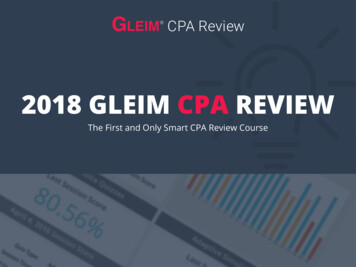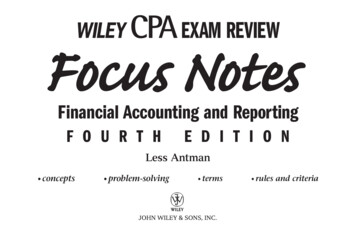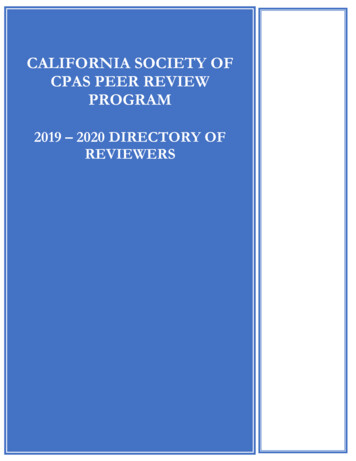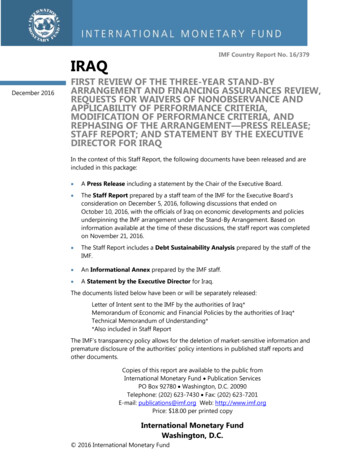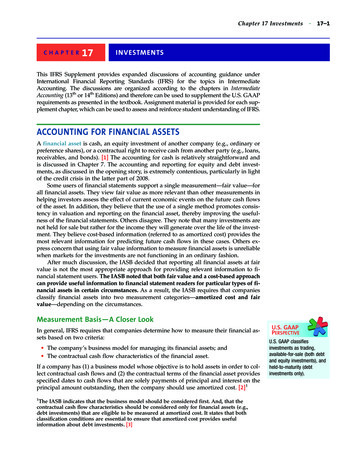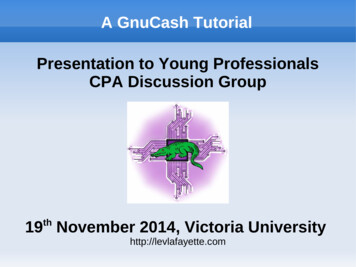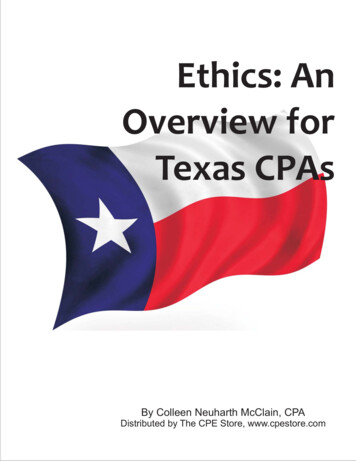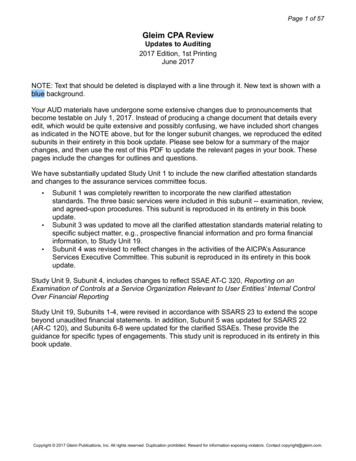
Transcription
Page 1 of 57Gleim CPA ReviewUpdates to Auditing2017 Edition, 1st PrintingJune 2017NOTE: Text that should be deleted is displayed with a line through it. New text is shown with ablue background.Your AUD materials have undergone some extensive changes due to pronouncements thatbecome testable on July 1, 2017. Instead of producing a change document that details everyedit, which would be quite extensive and possibly confusing, we have included short changesas indicated in the NOTE above, but for the longer subunit changes, we reproduced the editedsubunits in their entirety in this book update. Please see below for a summary of the majorchanges, and then use the rest of this PDF to update the relevant pages in your book. Thesepages include the changes for outlines and questions.We have substantially updated Study Unit 1 to include the new clarified attestation standardsand changes to the assurance services committee focus. Subunit 1 was completely rewritten to incorporate the new clarified attestationstandards. The three basic services were included in this subunit -- examination, review,and agreed-upon procedures. This subunit is reproduced in its entirety in this bookupdate.Subunit 3 was updated to move all the clarified attestation standards material relating tospecific subject matter, e.g., prospective financial information and pro forma financialinformation, to Study Unit 19.Subunit 4 was revised to reflect changes in the activities of the AICPA’s AssuranceServices Executive Committee. This subunit is reproduced in its entirety in this bookupdate.Study Unit 9, Subunit 4, includes changes to reflect SSAE AT-C 320, Reporting on anExamination of Controls at a Service Organization Relevant to User Entities’ Internal ControlOver Financial ReportingStudy Unit 19, Subunits 1-4, were revised in accordance with SSARS 23 to extend the scopebeyond unaudited financial statements. In addition, Subunit 5 was updated for SSARS 22(AR-C 120), and Subunits 6-8 were updated for the clarified SSAEs. These provide theguidance for specific types of engagements. This study unit is reproduced in its entirety in thisbook update.Copyright 2017 Gleim Publications, Inc. All rights reserved. Duplication prohibited. Reward for information exposing violators. Contact copyright@gleim.com.
Page 2 of 57Study Unit 1 – Engagement ResponsibilitiesPage 9, Introduction paragraph 2:The 11 attestation standards address many practitioner services. Most are considered in moredetail in other study units. The following are the relevant pronouncements for these services and theassociated acronyms:Statements on Standards for Accounting and Review Services (SSARSs) are codified asAR-C 60, 70, 80, and 90. They are issued by the AICPA’s Accounting and Review ServicesCommittee (ARSC). They apply to preparations, compilations, and reviews of nonissuers’ financialstatements.Statements on Auditing Standards (SASs) are codified using the AU-C prefix. They are issuedby the Auditing Standards Board. They apply to audits of nonissuers’ financial statements.Statements on Standards for Attestation Engagements (SSAEs) have been clarified andcodified. The comprehensive sections are AT-C 105, 205, 210, and 215. They are issued by theAICPA’s Auditing Standards Board (ASB) or other AICPA designated body. They apply toexaminations, reviews, and agreed-upon procedures engagements for subject matter other thantraditional financial statements.The Sarbanes-Oxley Act of 2002 (SOX) is federal legislation that has had a dramatic effect onthe engagement responsibilities of public accounting firms. The act created the Public CompanyAccounting Oversight Board (PCAOB). The PCAOB’s standards apply to audits of issuers bypublic accounting firms. Issuers and entities are required to file with the SEC.Pages 9-12, Subunit 1.1: The outline and questions for this whole subunit have been replacedwith the following eight pages:Copyright 2017 Gleim Publications, Inc. All rights reserved. Duplication prohibited. Reward for information exposing violators. Contact copyright@gleim.com.
Page 3 of 57The material in Subunit 1.1 is an overview of the SSAEs and the three kinds of engagements covered.Study Unit 19 addresses attestation engagements for specific subject matter (e.g., prospective financialinformation, compliance, etc.). Those subunits include additional requirements and report content. Readingthis overview may be helpful as you study that material.1.1 ATTEST ENGAGEMENTS1.Nature of an Attest Engagementa.Attestation standards apply when the CPA is engaged to issue or issues apractitioner’s examination, review, or agreed-upon procedures report on (1) subjectmatter or (2) an assertion about subject matter that is the responsibility of anotherparty. The subject matter of an attestation engagement can take many forms (incontrast with an audit of financial statements). The following are examples:1)2)3)4)5)6)b.Historical or prospective performance (e.g., performance measures)Physical characteristics (e.g., square footage of facilities)Historical events (e.g., the price of a group of goods at a certain date)Analyses (e.g., breakeven analyses)Systems and processes (e.g., internal control issues)Behavior (e.g., corporate governance compliance with human resourcepractices)The three types of attestation engagements are (1) examinations, (2) reviews, and(3) agreed-upon procedures. The basic concept of an attestation engagementis that a party who is not the practitioner makes an assertion about whether thesubject matter is measured or evaluated in accordance with suitable criteria. Thepractitioner gathers evidence and reports on the subject matter or assertion.1)2)2.The party who engages the practitioner is the engaging party.The party responsible for the assertion is the responsible party. Most oftenthe engaging party is the responsible party. For example, management as theresponsible party engages the practitioner to report on subject matter.Preconditions for an Attestation Engagementa.b.The practitioner should be independent unless required by law or regulation to acceptthe engagement and report.The practitioner should determine that1)2)The responsible party is a party other than the practitioner and takesresponsibility for the subject matter.The engagement has the following characteristics:a)b)c)d)3.The subject matter is appropriate.The criteria to be applied in the preparation and evaluation of the subjectmatter are suitable and will be available to the intended users.The practitioner expects to obtain the evidence needed for the opinion,conclusion, or findings.A written report includes the opinion, conclusion, or findings in appropriateform.Professional Expectationsa.b.The engagement should be planned and performed with appropriate professionalskepticism.The practitioner should exercise professional judgment in all aspects of theengagement.Copyright 2017 Gleim Publications, Inc. All rights reserved. Duplication prohibited. Reward for information exposing violators. Contact copyright@gleim.com.
Page of 57 4.Comparison of the Three Types of Engagementsa.The table below is an overview of the issues related to the different d-Upon ProceduresIndependence required?YesYesYesWritten assertion required?Yes, if engaging party isresponsible partyYes, if engaging party isresponsible partyNo, but lack of assertiondisclosed in reportType of reportOpinionWhether a material modificationFindings of specific proceduresis neededLevel of assuranceHighLimitedAmount of evidenceSufficient and appropriate to Sufficient and appropriate tosupport opinionsupport conclusionFindings of specific proceduresDocumentation (workingpapers) required?YesYes5.Findings of specific proceduresYesFailure to Provide a Written Assertiona.An engaging party may not be the responsible party, for example, a company seekingto acquire another company. The table below summarizes the consequences of theresponsible party’s refusal to provide a written assertion in each type of attestationengagement.Identity of Responsible PartyExaminationReviewAgreed-Upon ProceduresEngaging party is the responsibleWithdraw from engagementpartyWithdraw from engagement Disclose refusal in reportEngaging party is not theresponsible partyDisclose refusal in report6.Disclose refusal in reportEngagement Documentationa.b.c.7.Disclose refusal in reportThe practitioner should prepare engagement documentation on a timely basis.It should suffice to (1) describe the nature, timing, and extent of the proceduresperformed and (2) identify the specific items or matters tested. It also should state(1) who performed the work, (2) the date such work was completed, (3) who reviewedthe work, and (4) the date and extent of such review.The practitioner should assemble documentation in an engagement file. Theadministrative process of assembling the final engagement file should be completedno later than 60 days after the report release date.After the documentation completion date, the practitioner should not delete ordiscard any documentation before the end of its retention period. However, in somecases items may be added.Examination Engagements (AT-C 205)a.An attestation examination is similar to an audit. In an audit, the auditor expressesan opinion on the fairness of the financial statements. In an examination, theindependent practitioner expresses an opinion on (1) the fairness of an assertion bythe responsible party or (2) whether the subject matter (not in the form of generalpurpose financial statements) is in accordance with (or based on) criteria. Thatsubject matter can take many forms if it can be measured and evaluated againstreasonable criteria. Examples include the following:1)2)Financial data, such as whether breakeven analysis for ABC Company is fairlypresented for year 20X1Value data, such as the fairly stated value of plant assets owned by ABCCompany at year end 20X1Copyright 2017 Gleim Publications, Inc. All rights reserved. Duplication prohibited. Reward for information exposing violators. Contact copyright@gleim.com.
Page of 573)b.c.Compliance data, such as whether ABC Company complied with lendingcovenants for 20X1The service is inappropriate for subject matter if no measurable criteria exist or thecriteria are subjective. Examples include the following:1) ABC Company is the best company in the industry.2) ABC Company has made progress in becoming solvent.The objectives of an examination engagement are to1)d.Obtain reasonable assurance about whether the subject matter as measuredor evaluated based on the criteria is free from material misstatement2) Express an opinion in a written report about whether (a) the subject matter isin accordance with (or based on) the criteria, in all material respects, or (b) theresponsible party’s assertion is fairly stated, in all material respects3) Communicate further as required (e.g., to those charged with governance)Differences between Examinations and Audits1)2)In general, similar requirements apply to examinations and audits. This similarityshould be considered when studying the auditing requirements.An examination differs from an audit in the following significant ways:a)e.A request for a written assertion from the responsible party is required.(In an audit, the assertions are deemed to be embodied in the financialstatements.)b) The subject matter is not historical financial statements.c) The engaging party may not be the responsible party.d) Use of the report is more likely to be restricted.e) Use of analytical procedures is less likely because the subject matter maybe qualitative, not quantitative.Performance of an Engagement1)f.Materiality should be considered when (a) planning and performing theexamination and (b) determining the nature, timing, and extent of procedures.2) Professional judgment should be used to determine the nature, timing, andextent of examination procedures. Those procedures should provide sufficient,appropriate evidence to support the practitioner’s opinion.3) The practitioner should focus on matters subject to increased risks and materialmisstatement.Evaluating the Results of Procedures1)g.The practitioner should accumulate misstatements identified during theengagement, if not clearly trivial, to determine the effect on the opinion.Written Representations1)h.The responsible party should provide a written representations letter addressedto the practitioner.Forming the Opinion and Preparing the Report1)The practitioner should form an opinion about whether (a) the subject matteris in accordance with (or based on) the criteria, in all material respects, or(b) the assertion is fairly stated, in all material respects. The practitioner shouldevaluatea)b)The conclusion about the sufficiency and appropriateness of evidence andWhether uncorrected misstatements are material, individually or in theaggregate.Copyright 2017 Gleim Publications, Inc. All rights reserved. Duplication prohibited. Reward for information exposing violators. Contact copyright@gleim.com.
Page of 572)3)The report should be in writing. It should express an opinion (a) on a writtenassertion or (b) directly on the subject matter. If the report is on theassertion, it should accompany the report or be clearly stated in the report.The following is an example of a paragraph expressing an opinion directly on thesubject matter:EXAMPLEIn our opinion, [identify the subject matter, e.g., the schedule of investment returns of XYZ Company for the year endedDecember 31, 20XX], is presented in accordance with [identify the criteria, e.g., the ABC criteria set forth in Note 1], in allmaterial respects.4)8.The report should include an alert, in a separate paragraph, that restricts theuse of the report when the criteria used to evaluate the subject matter areappropriate only for a limited number of parties.Review Engagements (AT-C 210)a.An attestation review is similar to a review of financial sta
Nature of an Attest Engagement a. Attestation standards apply when the CPA is engaged to issue or issues a practitioner’s examination, review, or agreed-upon procedures report on (1) subject matter or (2) an assertion about subject matter that is the responsibility of another party. The subject matter of an attestation engagement can take many forms (in
